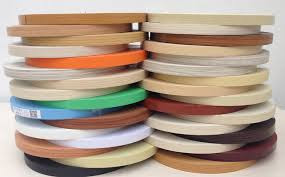Edge Banding is the name of
both a process and an associated narrow strip of material used to create
durable and aesthetically pleasing trim edges during finish carpentry.Melamine edge banding
is used to cover the exposed sides of materials such as plywood, particle board or MDF, increasing durability and giving the appearance of a solid or more
valuable material. Common substitutes for edge banding include face frames or molding.
Advantages of using melamine:
Melamine is a plastic coating applied to sheet goods, such as particle
board, MDF or plywood. It is used in cabinet making and provides a clean, stain
resistant and durable surface. Covering the raw edges of melamine is the key to
giving it a finished appearance. Like veneer edging, melamine edging requires heat
to activate the adhesive on its backing; your household clothes iron is a good
tool for heating up your edge banding. Besides an iron, you will need a smooth
block of wood and a sharp chisel or edge trimmer.
Steps to roll out edge banding at
home:
1. Sand the edge of the melamine piece to be edge banded to
remove any saw marks or uneven areas.
2. Roll out enough heat-press melamine edge banding to cover the
edge of the board. Estimate an excess hang over of about 1/2 inch at each
end.
3. Set your clothes iron to "Medium Heat." Place the
board on a steady, level surface and hold the melamine edge banding in place on the melamine, glue side down.
Starting from one end, apply the hot iron to the melamine edge banding.
4. Work the edging in small sections. Heat the glue and press it
into place with a smooth wood block, firmly.

Comments
Post a Comment